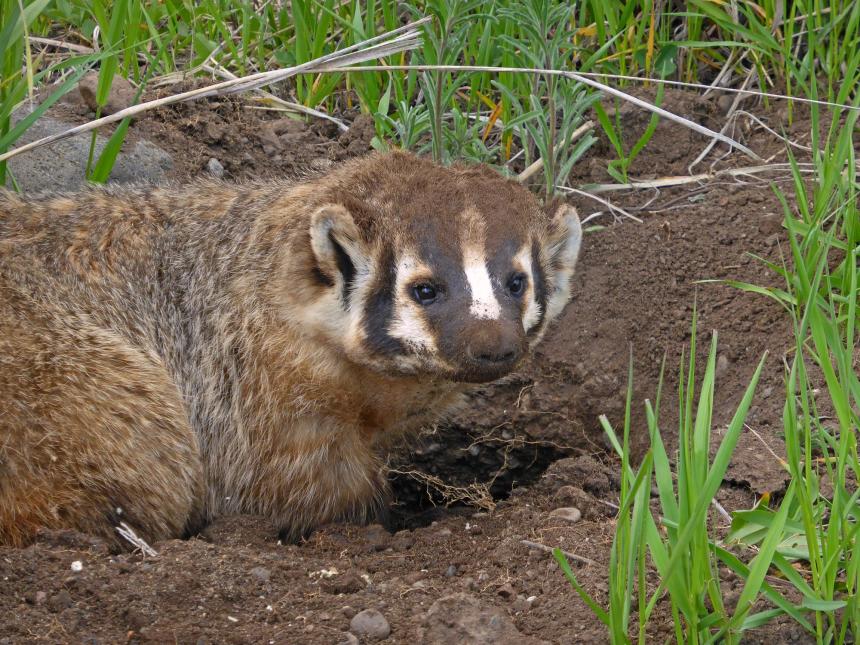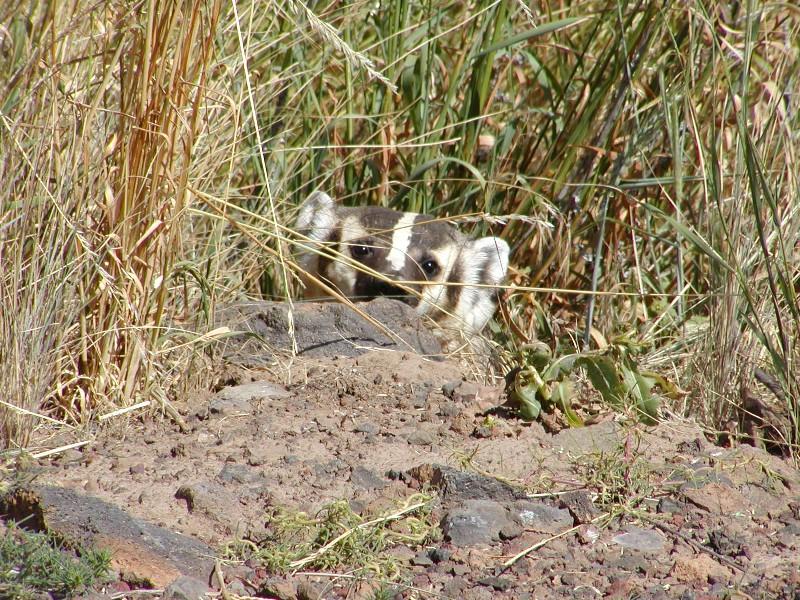Population size of the American badger in Washington is unknown, but there is concern that the statewide population is declining.
Description and Range
Physical description
The American badger is a mid-sized (10 to 11 pounds), burrowing mammal of the weasel family that uses underground burrows for resting, denning, and prey caching. They are well-suited for burrowing and digging: they have large, powerful shoulders; stout front legs and feet; large front claws; and short ears. Their distinctly colored faces sport black patches over a white throat, chin, and cheeks.
The American badger is classified as a furbearing species in Washington, but few badgers have been captured for their fur since 1995.
Ecology and life history
American badgers are generally found in grassland, shrubsteppe, desert, dry forest, parkland, and agricultural areas. They require soils that allow the excavation of den sites and support burrowing prey species (such as ground squirrels).
American badgers forage underground by digging into the burrow systems of prey species, which commonly include ground squirrels, prairie dogs, marmots, and pocket gophers. Badgers also feed on carrion, insects, reptiles, and birds. Burrows excavated by American badgers are used by other bird and mammal species.
They are a solitary species, and they use large home ranges that may overlap with other American badgers of either sex. Gray wolves, coyotes, bears, and cougars are reported predators of American badgers, but for many populations, anthropogenic (man-made) causes (vehicle collisions, illegal shooting, and trapping) appear to be a more significant source of mortality.
In the spring, female badgers give birth to litters ranging from one to five kits. The young badgers stay in their grass-lined den, nursing until 3 months of age. Juveniles may emerge from the den as early as 2 months but stay with their mother until 5 to 6 months old.
Geographic range
The current distribution of American badgers includes portions of eastern Washington from the eastern Cascade foothills to the Idaho border. They have also been detected in the high-elevation parklands of the North Cascade Ecosystem.
For a map of worldwide distribution and other species' information, check out NatureServe Explorer.
Climate vulnerability
Sensitivity to climate change
Moderate
In general, sensitivity of the American badger appears to be mostly driven by prey and habitat specialization. Badgers occur in shrub-steppe, grassland, semi-desert, and open forest habitats, require friable soils for digging, and prey primarily on ground squirrels, pocket gophers, and a variety of other small mammals. Warmer, drier conditions that lead to more frequent and hotter fires and/or encourage the growth of invasive plants (e.g., cheatgrass) may degrade or alter natural habitat for badgers by negatively impacting some prey species (e.g., ground squirrels). However, warmer and drier conditions may also allow grassland and prey expansion, especially at higher elevations, thereby possibly creating more habitat for badgers. Based on these conditions, badgers may decline in the Columbia Basin, but increase in the east Cascades and other eastside mountainous areas.
Exposure to climate change
Moderate
- Increased temperatures
- Changes in precipitation
- Altered fire regimes
- Increased invasive plants
Conservation
Conservation Threats and Actions Needed
- Resource information collection needs
- Threat: Adequate data on species abundance, trend, and threats are lacking.
- Action Needed: Undertake comprehensive field surveys to determine abundance, habitat use, and threats.
- Fish and wildlife habitat loss or degradation
- Threat: Habitat loss and fragmentation from agriculture and other development.
- Action Needed: Conduct research and modeling of habitat using findings of habitat associations from badger surveys. Use these findings to prevent further loss and decline of habitat.
- Overharvesting of biological resources
- Threat: Illegal killing and persecution.
- Action Needed: Enforce existing protective regulations. Conduct education and outreach to landowners and recreationists.
- Threat: Lack of adequate prey availability may limit badger abundance in some areas.
- Action Needed: Work to restore populations of ground squirrels and other prey species.
Resources
References
Lindzey, F. G. 2003. Badger (Taxidea taxus). Pages 683-691 in G. A. Feldhamer, B. C. Thompson, and J. A. Chapman, editors. Wild mammals of North America: biology, management and conservation, 2nd edition. Johns Hopkins University Press, Baltimore, Maryland.
Rahme, A. H., A. S. Harestad, and F. L. Bunnell. 1995. Status of the badger in British Columbia. Wildlife Working Report WR-72, Ministry of Environment, Lands and Parks (Wildlife Branch), Victoria, British Columbia.

